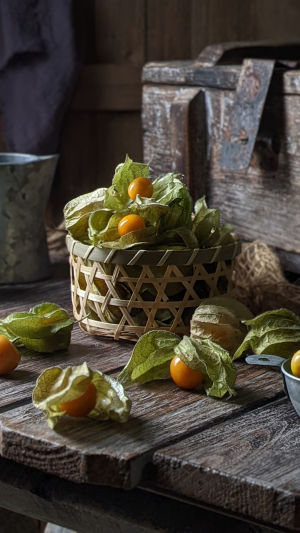The Peruvian groundcherry, also known as Physalis peruviana or golden berry, is a small, vibrant fruit that has been cherished in South America for centuries. This tiny, golden fruit is encased in a papery husk and has a unique sweet-tart flavor that’s often compared to a mix of pineapple and tomato.
While its origins trace back to the Andean regions of Peru, it has gained popularity worldwide for its nutritional benefits and versatility in culinary applications.
<h3>A Nutritional Benefits</h3>
<b>Vitamin C:</b> Peruvian groundcherries are packed with vitamin C, making them an excellent choice for boosting immunity and promoting healthy skin.
<b>Fiber:</b> These berries are rich in dietary fiber, aiding digestion and helping maintain a healthy gut.
<b>Antioxidants:</b> The vibrant color of the Peruvian groundcherry indicates its high antioxidant content, which helps protect the body against free radicals and reduces inflammation.
<h3>Culinary Uses of Peruvian Groundcherry</h3>
The unique flavor of Peruvian groundcherry makes it a versatile ingredient in both sweet and savory dishes.
<b>Salads:</b> Add a pop of color and tangy flavor to your salads by tossing in some halved groundcherries.
<b>Desserts:</b> These berries are a perfect addition to desserts like tarts, cheesecakes, and fruit salads.
<b>Snacking:</b> Enjoy them fresh as a healthy snack or dry them for a chewy, sweet treat.
<b>Sauces and Chutneys:</b> Use Peruvian groundcherries to create a sweet and tangy sauce that pairs well with grilled meats or as a topping for sandwiches.
<h3>Growing Peruvian Groundcherry at Home</h3>
<b>Climate and Soil:</b> Peruvian groundcherry plants thrive in warm, temperate climates and prefer well-drained soil with plenty of organic matter. They can be grown in containers or directly in the ground.
<b>Planting:</b> Start seeds indoors about six to eight weeks before the last frost. Transplant seedlings outdoors after the danger of frost has passed.
<b>Care:</b> Groundcherries require full sun and regular watering, but they are relatively low-maintenance. The plants will produce fruit from late summer to early fall.
<b>Harvesting:</b> The fruits are ready to harvest when the husks turn brown and start to dry out. The berries will fall to the ground when fully ripe, hence the name "groundcherry."
<h3>Why You Should Add It to Your Diet?</h3>
Peruvian groundcherries are not only delicious but also offer numerous health benefits. Their high content of vitamins, antioxidants, and fiber makes them a great addition to a balanced diet. Whether you enjoy them fresh, dried, or incorporated into your favorite dishes, these golden berries are a must-try for any fruit lover.
<h3>Price Overview</h3>
<b>Fresh Groundcherries:</b> Typically $5 to $8 per pound, or $3 to $6 per pint.
<b>Dried Groundcherries:</b> Generally $10 to $15 per pound.
Factors like availability, organic certification, and seasonality can influence these prices.
The Peruvian groundcherry is a small fruit with big benefits. From its nutritional value to its versatility in the kitchen, it’s no wonder this Andean berry has become a global favorite. Whether you’re growing it in your garden or picking it up at the market, the Peruvian groundcherry is sure to add a burst of flavor and a boost of health to your meals.
You HAVE TO GROW Peruvian Ground Cherry (aka GOLDENBERRY) | Gardening Tips & Tricks Seed to Harvest
Video By San Diego Seed Company





